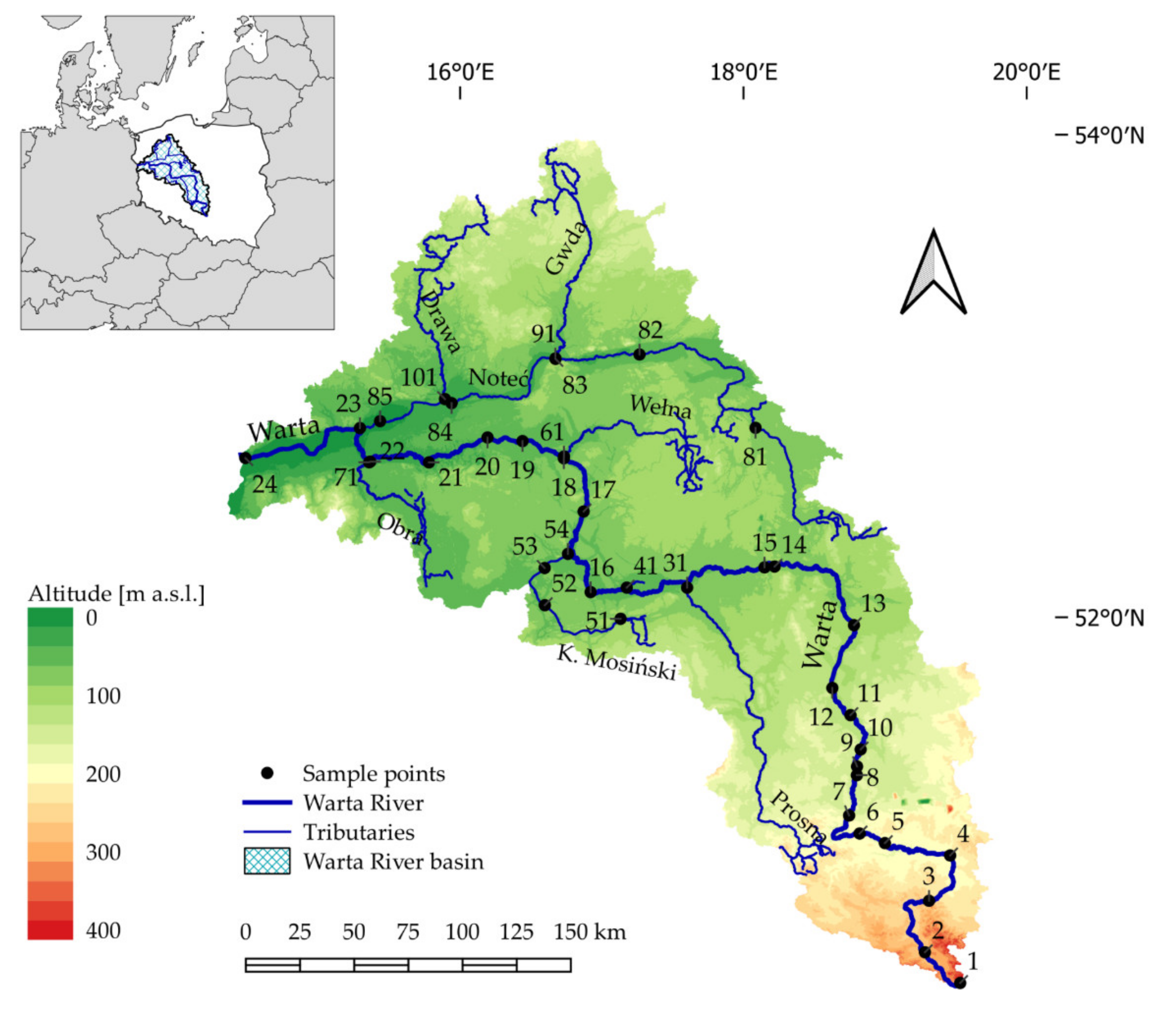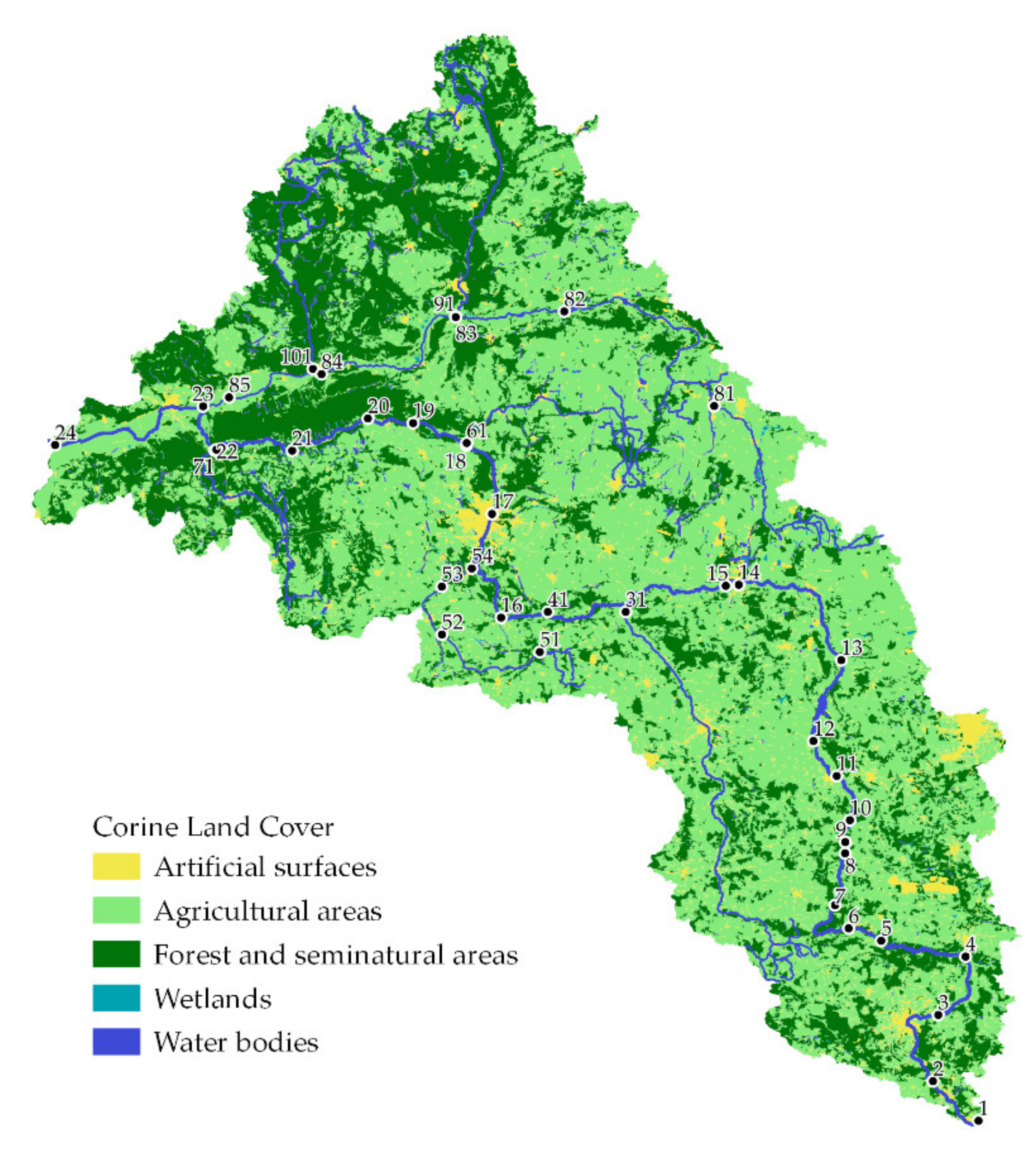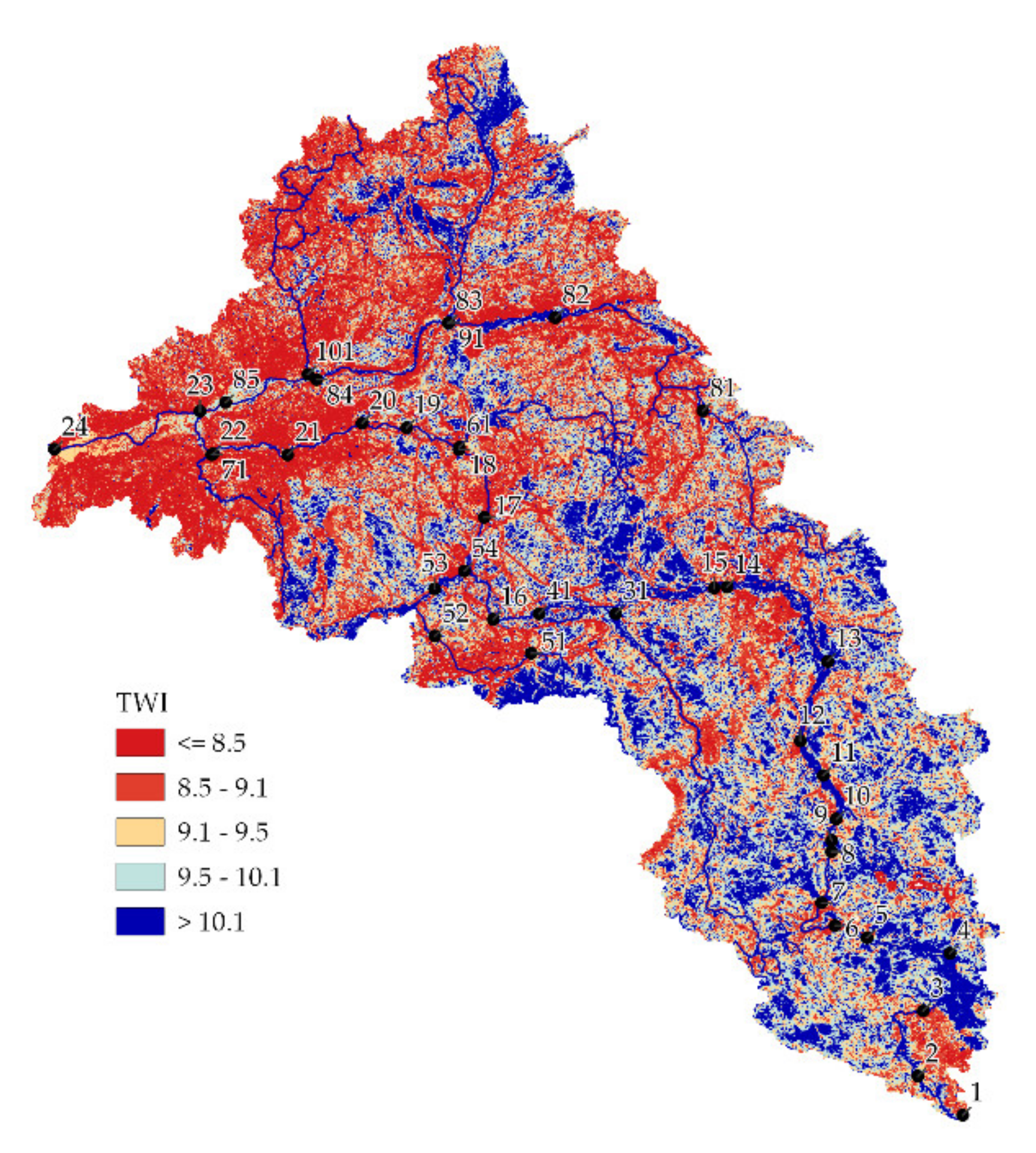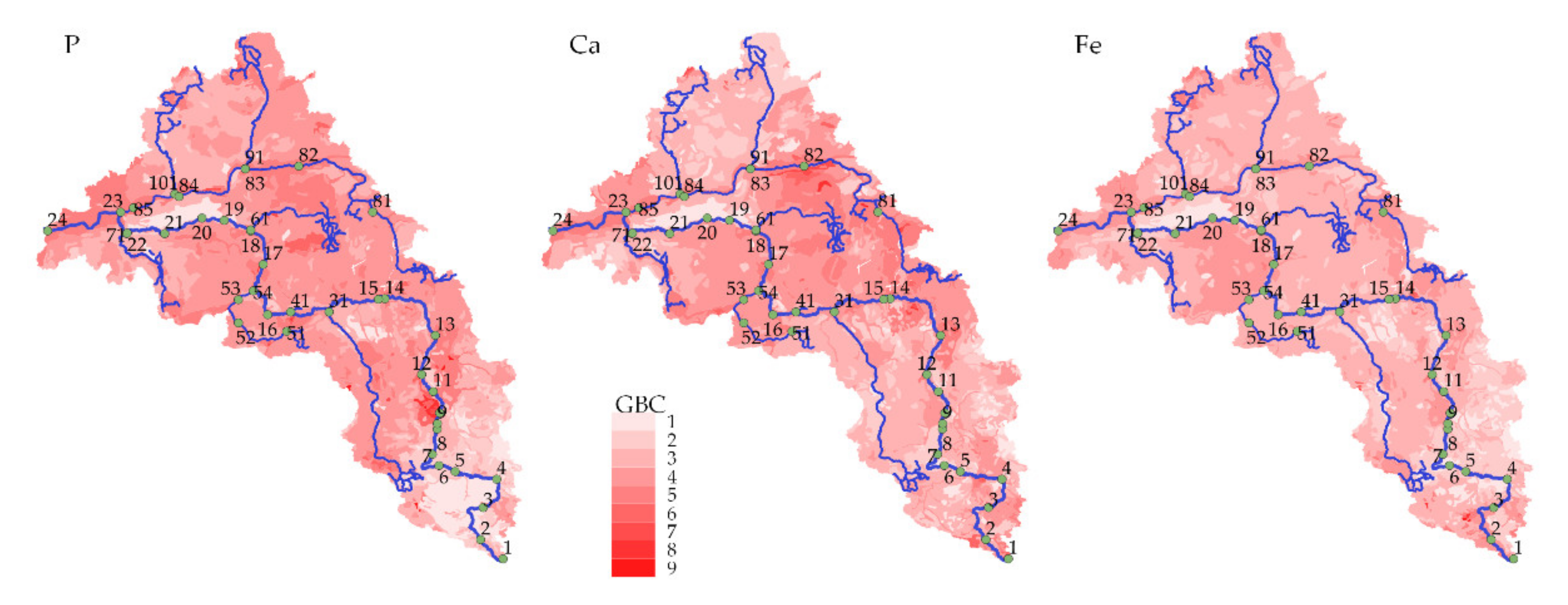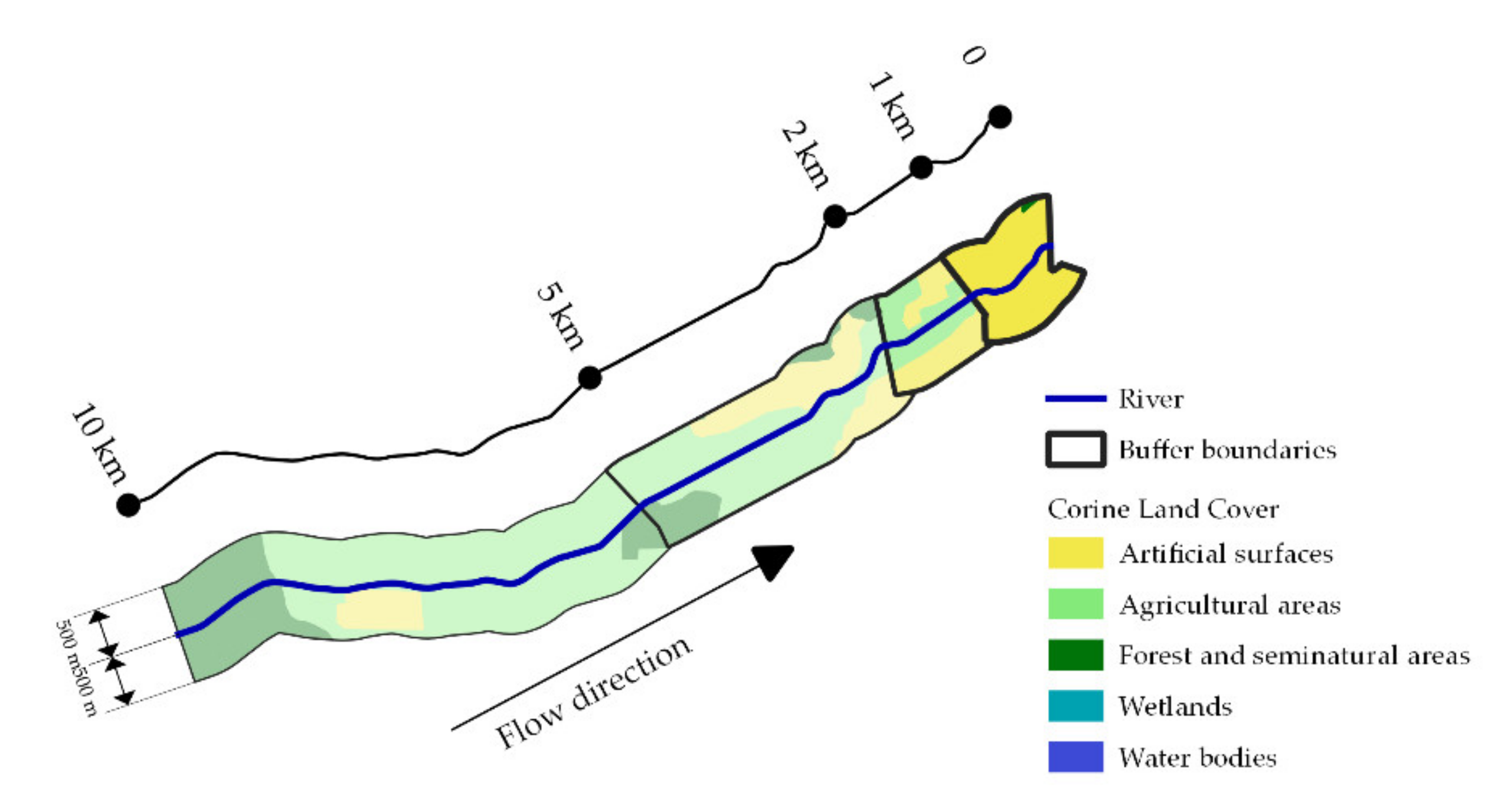1. Introduction
River sediments are an important part of the cycling of materials in the aquatic ecosystem. The understanding of the pollution processes of river bottom sediments is of great importance because it can be an indicator of the ecological health of waters [
1]. Sediments can accumulate pollutants and act as a buffer to absorb and release pollutants into the aquatic environment [
2]. Loads of constituents such as carbon, nitrogen and phosphorus in bottom sediments and their interrelationships enable identification of the sources of organic matter and its transformations. The ratios of these constituents are affected by several environmental factors such as climate [
3,
4], terrestrial inflows, morphometry and use of adjacent areas [
5] or the mineralogical composition of sediments [
6]. Biochemical and biological transformations taking place in sediments and at the water–sediment interface [
7,
8], as well as the hydrodynamic processes of sediment transport in riverbeds [
9], are also of great importance for concentrations and mutual proportions of constituents that can be found in bottom sediments.
The land-use pattern of the area located in the catchment is one of the more important factors affecting the concentrations of nutrients, as well as other pollutants, in river bottom sediments [
10]. Intense agricultural production can be a significant source of nutrient inputs to surface waters, both as diffuse and point sources of pollution [
11,
12]. This impact varies over time and depends, among other things, on changes in agricultural production technology [
13]. Szatten and Habel [
14] showed that the decrease of intensive agricultural areas results in the reduction of sediments and nutrients loads flowing into the reservoir. Additionally, urbanised areas were indicated as a source of surface water pollution [
15,
16] and, consequently, also bottom sediment pollution. However, as indicated by Khatri and Tyagi [
15], the anthropogenic factors affecting water pollution in rural areas differ from those in urban areas. The chemical composition of bottom sediments of the water bodies located in urban and industrial areas shows anthropogenic enrichment with organic matter, phosphorus, calcium and trace elements [
17]. An increase in impermeable surfaces in these areas increases surface runoff and erosion processes, causing an increased inflow of sediments to rivers [
18]. In turn, afforested areas enable a reduction in the inflow of pollutants to watercourses and, consequently, reduce their deposition in bottom sediments. Riparian forest buffer systems are an effective tool for controlling the number of sediments and related pollutants carried in surface runoff [
19]. Forest ecosystems also reduce the leaching of soluble nutrients into stream water [
20]. In this regard, there is a frequent emphasis on the role of riparian vegetation that can act as a buffer to intercept suspended sediments and pollutants [
21]. Forested riparian zones can reduce loads of suspended sediment in the runoff by 90% [
22]. Grass riparian filter strips show a similar reduction of sediments in runoff as observed in forested zones, while the reduction of nitrogen and phosphorus is near 50% [
23,
24]. However, using only the primary type of land use may not be sufficient to explain the influx of pollutants to the aquatic environment fully. Liu et al. [
6] showed that more fragmented forms of land use would give higher pollutant loads even if they are of the same primary type of land use.
The assessment of a qualitative status of bottom sediments requires the adoption of certain standards defining the concentrations of chemicals, the exceeding of which causes the sediments to be considered polluted. This is mainly due to the simplicity and ease of their application in practice. These standards, depending on a local controller, may address a variety of substances, including organic carbon, nutrients, heavy metals, organic compounds and others, and have different thresholds [
25,
26].
The chemicals that make up bottom sediments are interrelated. According to previous studies, the relationships between TN, TP and TOC concentrations are the result of biochemical and geochemical processes occurring in the environment and enable the identification of the sources of pollution [
27,
28]. Carbon–nitrogen ratio is one of the main variables to determine the source of organic matter in rivers [
29]. Yun and An [
30] indicated that the N:P ratio could be used in diagnosing the ecological health of a stream. Additionally, the relationships between TP concentrations and Fe, Ca and TOC concentrations are indicated, but the links between these elements can be different for each river [
31].
The researches on the quality of riverine bottom sediments in lowland areas of Poland conducted in recent years has focused mainly on the analysis of concentrations and hazards caused by heavy metals [
32,
33,
34], while the risks of nutrients or organic matter have not been analysed in detail.
This study aims to analyse the spatial variability of TN, TP, TOC, Ca, Fe and K concentrations and their interrelationships in bottom sediments of the Warta River and its tributaries. The analysis also considered the effects of land cover structure and P, Ca and Fe concentrations in soils, found in areas adjacent to sediment sampling sites, on sediment composition for different lengths of the contact zone between the river and surrounding areas. This enables the assessment of sediment quality and the identification of factors affecting the concentrations of nutrients in sediments.
3. Results and Discussion
3.1. General Characteristics of Concentration Variability
The results of measurements made in 2016 for TN, TP, Ca, Fe and TOC concentrations found in the bottom sediments of the Warta River and its tributaries are shown in
Table A1. Concentrations of individual elements are within N: 71.5–16,240 mg-kg
−3, P: 48.8–8864 mg-kg
−1, Ca: 423–54,010 mg-kg
−1, Fe: 1602–68,280 mg-kg
−1 and TOC: 0.20–21.50 % d.m.
The average concentrations of the analysed elements ranged from 13,182 mg-kg
−1 for Fe through 9320 mg-kg
−1 for Ca, 2169 mg-kg
−1 for N to 1130 mg-kg
−1 for P and 3.76% for TOC (
Table 3). The median values are 8269 mg-kg
−1, 11,078 mg-kg
−1, 998 mg-kg
−1, 464 mg-kg
−1 and 2.18% for Fe, Ca, N, P and TOC, respectively. The TOC values measured in 1998–2000 are similar to those measured in bottom sediments of the Oder, which is a receiving body for the water of the Warta River, when they ranged from 0.2% d.m. to 18.2% d.m., averaging 4.9% d.m [
53]. Similar values for P, Ca, Fe and TOC concentrations were observed by House and Denison [
31,
54] in seven rivers in southern England. Their reported data concerning concentrations were 40–47,000 mg-kg
−1 for Fe, 40–19,000 mg-kg
−1 for Ca, 10–2000 mg-kg
−1 for P and 0.6–19% d.m. for TOC. This may indicate similar sources of sediment pollution and similar land use of catchments.
The IQR values shown in
Table 3 were 2685 mg-kg
−1, 1084 mg-kg
−1, 9934 mg-kg
−1, 13,821 mg-kg
−1 and 3.18% for TN, TP, Ca, Fe and TOC, respectively. The IQR test showed several outliers involving N concentrations in the Warta River bottom sediments at site no. 4 and the Noteć River sediments at site no. 82. For phosphorus, concentration outliers were found in the Warta River sediments at sites no. 4, 19, 20 and in the Noteć River sediments, at site no. 82. For Ca, outliers were observed in the Mosiński Canal at sites no. 51 and 53. For Fe, outliers were found in the Noteć River at site no. 82. Outlier TOC values were observed in the Warta River sediments at site no. 4 and in the Noteć River bottom sediments at sites no. 82, 83 and 84. The outliers were most frequently observed at site no. 82 (Noteć River)—four times and three times higher/lower at sites no. 4 and 23 (Warta River).
The analysis of distributions of the analysed concentrations showed that none of the concentration distributions is a normal distribution (
Figure 6). In contrast, for all
p > 0.05 parameters, all distributions are similar to a log-normal distribution.
All analysed concentrations are strongly positively correlated with one another. Spearman’s correlation coefficients range from 0.50 for the correlation between TOC and Ca to 0.93 for the correlation between TP and Fe. Almost all correlation coefficients are significant at the
p < 0.0001 level (
Table 4). Only the TOC–Ca correlation is significant at the
p < 0.01 level, whereas the TOC–K correlation is significant at the
p < 0.001 level. The strongest correlation is between Fe concentrations and TP, Ca and K concentrations, for which the correlation coefficients are 0.93, 0.87 and 0.86, respectively. In contrast, the correlations between TOC and Ca/K are the least correlated, but still significant at the
p < 0.01 level.
Inorganic constituents that can combine with or adsorb phosphates are one of the factors affecting TP concentrations in bottom sediments [
55,
56]. Immobilising components include metals, such as iron, which combine with phosphorus, forming crystalline metal phosphates (e.g., strengite or vivianite), or they can adsorb phosphorus on the oxide/hydroxide layer. In the case of the presence of large amounts of calcium, phosphate precipitation may occur in the form of hydroxylapatite (HA) or various calcium phosphates [
55,
57,
58]. Furthermore, iron (III) plays an important role in the phosphate sorption by humic elements, forming iron (III)–humus complexes with phosphates [
55,
59].
3.2. C:N:P Stoichiometry
The calculated characteristic values of C:N, C:P and N:P ratios indicate their high variability as shown in
Table 5 and
Figure 7. C:N values range from 4.51 to nearly 112, with a median value of 22.98. The highest C:N values of 112, 81, 68 and 61 were observed at sites no. 11, 52, 3 and 21, respectively. A total of 33 sites had C:N > 10, two sites had ratios similar to 10, and only four sites had C:N < 10 (
Figure 7). This indicates that the organic matter found in bottom sediments derives mainly from runoff from surrounding areas. Similarly, high C:N values were also obtained by Lu [
60], indicating that exogenous sources of pollution are the cause. On the other hand, the lowest C:N values have sediments at sites located in the vicinity of the aforementioned site no. 52, i.e., sites no. 51 and 53–4.5 mg-kg
−1 and 6.9 mg-kg
−1, respectively. The bottom sediments at these two sites have high nitrogen concentrations as well as very high P, Ca and Fe concentrations (
Table A1).
C:P ratio values in bottom sediments of rivers of the Warta River catchment ranged from 6.83 to 501.27, with a mean value of 58.3. The highest value of this parameter was obtained for site no. 83—the Noteć River, while the lowest for site no.—the Mosiński Canal.
N:P ratios in the bottom sediments of rivers of the Warta River catchment ranged from 0.28 to 15.37, with a mean value of 2.32. According to Chen et al. [
45], low N:P values correspond to eutrophic and mesotrophic conditions with the predominant supply of nutrients derived from external sources. The nutrients from such sources are complex and have low N:P ratios. In contrast, high TN/TP values can be observed under oligotrophic conditions when natural nutrient supply sources have high N:P ratios. Knösche [
55] reports that the TN:TP ratio in river sediments decreases significantly from low-density Paleopotamal sediments (median TN:TP = 23.7) to high-density Eupotamal sediments (median 8.5). He also observed a similar correlation for the TOC:TP ratio. At the same time, Ostendorp [
61] indicated that N:P:OC ratios could be explained by the variability of organic content rather than by eutrophication processes in each case.
3.3. Single Pollution Index (SPI)
The pollution status of bottom sediments of the rivers of the Warta River catchment shows great spatial variation, as shown in
Figure 8. SPI values for nitrogen range from 0.13 to 29.5. The largest proportion of sediment samples, 41%, can be classified as Class I (
Table 6). Class II includes 13% of the samples. Sampling sites with a low risk of nitrogen pollution are located mainly in the upper part of the Warta River (sites no. 1–14, excluding sites no. 4 and 12) and in its lower reaches (sites no. 18–24, excluding site no. 20). On the other hand, Class III includes 13% of sediment samples and Class IV, with the highest pollution, includes as many as 33% of samples. These sites are located primarily in the middle course of the Warta River and in its tributaries.
SPI values for sediments polluted with phosphorus ranged from 0.08 to 14.8. Classification of sediment samples classifies 39% of samples into Class I, 15% into Class II, 10% into Class III and 36% into Class IV. These values are similar to SPI for TN. As with nitrogen, the sampling sites classified as Class I and II are located in the upper and lower reaches of the Warta River. The SPI values for TOC allow 23% of sediment samples to be classified as Class I and 54% as Class II. On the other hand, 15% and 8% of sediment samples should be classified into Class III and IV, respectively. This indicates a much lower risk of bottom sediment pollution by TOC than by TN or TP. The lowest pollution risk to bottom sediments was found for Fe. SPI values ranging from 0.08 to 3.4 enabled 56%, 23%, 18% and 3% of the samples to be classified as classes II–V, respectively.
The obtained SPI values indicate a lower pollution risk to bottom sediments of the Warta River than those obtained by He et al. [
43] for Chinese rivers.
3.4. Spatial Variation of Pollutant Concentrations
The clustering analysis of TN, TP, TOC, Ca, Fe and K concentrations in bottom sediments using the Partitioning Around Medoids (PAM) identified three groups of bottom sediment sampling sites (
Figure 9). A simultaneous principal component analysis (PCA) found that the first two principal components, for which the eigenvalues are greater than 1, explain approximately 87% of the total variance (
Table 7).
The land-use structure, as determined by the CLC classification, shows varying effects on the levels of constituents found in river sediments of the Warta River catchment. Anthropogenic lands (C_1) and forests and semi-natural ecosystems (C_3) show a negative correlation, while agricultural lands (C_2) and lands covered by water (C_5) show a positive correlation with concentrations of all elements; however, this relationship is not statistically significant in most cases. It should be noted that previous studies highlighted the negative impact of urbanised areas on the quality of bottom sediments in rivers. This was mainly due to the impact of direct discharge of wastewater into rivers or increasing surface runoff from areas with impervious surfaces [
62,
63]. However, the following phenomena that have been marked in recent years, such as the connection of most wastewater sources to wastewater treatment plants, the increase of areas that enable rainwater infiltration or, for example, measures to retain rainwater runoff from impervious surfaces, may reduce or neutralise the negative impact of urbanisation on the quality of surface water and bottom sediments. The negative impact of agricultural areas is mainly caused by an increased input of nutrients [
12], inorganic suspended solids [
64] and organic matter [
65] from these areas to surface waters.
Factor loadings for the first two principal components are shown in
Table 8. According to the classification presented by Liu et al. [
66], factor loadings were classified as “strong,” “average,” and “weak” for values of >0.75, 0.75–0.50, and 0.50–0.30, respectively. PC1, which explains 67.4% of the total variance, has strong positive Fe, TN, TP and TOC loadings, while also showing average K and Ca loadings.
Table 9 shows the Spearman’s correlation coefficient values of TN/TP/K/Ca/Fe/TOC concentrations in bottom sediments with land cover structure in the zones of a width of 1000 m, adjacent to the river on a length of 1, 2, 5 and 10 km, and the calculated Ca, Fe and P content index of the topsoil.
The significance of the land-use impact depends not only on the land-cover structure itself, but also on the length of the contact zone of land adjacent to the watercourse. A significant (p < 0.05) effect of agricultural land (C_2) on the concentration levels of all analysed elements was observed for the 1 km buffer area. For longer buffer lengths, excluding K and TOC concentrations in the 2 km buffer area, that effect was no longer statistically significant. In contrast, the proportion of anthropogenic land (C_1) is significantly linked to P, K, Fe and TOC concentrations in the 5 km buffer area. Additionally, the proportion of the area covered by water (C_5) shows the strongest relationships with P, K, Ca and TOC concentrations in the 5 km buffer area. At the same time, the proportion of the land covered by water is the only one that is significantly correlated with phosphorus concentrations for all buffer lengths. Except for the effects of forest land proportion (C_3) on Fe concentrations in the 10 km buffer area, there was no significant impact of that land-use category on concentrations of analysed substances found in bottom sediments.
The results indicate a significant positive relationship between the geochemical background level of phosphorus in the 2 km buffer area and N, P, Ca, Fe and TOC concentrations in the bottom sediments analysed. In contrast, the geochemical background levels of Ca and Fe do not show such a relationship.
3.5. The Relationships between Water Quality Parameters and Land Use
The analysis of land use as identified based on the CLC data in individual buffers enabled four land-cover groups to be distinguished. The clustering results and the distribution of each group are shown in
Figure 10. The first group includes areas dominated by anthropogenic lands, with a low proportion of forests. The second group includes buffer areas that are predominantly forested. The third group includes buffer areas dominated by agricultural lands. The fourth group consists of buffer areas where the proportion of lands covered by water is at least 10%, regardless of other land-use categories.
The Spearman’s correlation coefficients between parameters describing constituent concentrations in bottom sediments for defined land-use groups are shown in
Table A2. In group 1, where anthropogenic land use is the main factor, the strongest relationship is between TP and Fe, TN and TOC concentrations. However, the relationships between the elements show a higher correlation in the case of buffers that were identified based on a significant proportion of forest land. The highest correlation is between TP and TN, TN and TOC and TP and Fe. Unlike cluster 1, there is also a strong correlation between TOC and Fe in cluster 2.
The highest levels of correlation between bottom sediment constituents occur when the river is adjacent to agricultural land (cluster 3). In this case, all correlation coefficients are statistically significant, at least at the p < 0.05 level. The highest correlation in cluster 3 is between Ca and K, TP and Fe and Fe and K. The lands included in cluster 4 have surface water within the buffer area, the proportion of which is between 10% and 20% (highest proportion) of the total buffer area. In the case of sediment samples collected at sites assigned to this cluster, the highest correlation occurred between Ca and K concentrations, where r = 1.0. Again, very high levels of correlation occurred between Fe and TP and Ca and K.
It should be noted that regardless of the influence of the environment, phosphorus concentrations show the highest correlation with iron concentrations and slightly lower correlation with calcium concentrations, which is due to the already mentioned mutual interactions between these constituents, leading to precipitation or release of phosphorus [
67,
68,
69]. The strong correlations between TP and TN concentrations for all use categories of the river-adjacent zones, except for the relatively low correlation for agricultural use, may indicate similar sources of nutrients in these areas. In agricultural lands, however, sources of pollution are of different nature—diffuse or point. Nutrients may derive from both field crops and animal husbandry, and they have different nutrient ratios, as also indicated by Lee [
70] and Jones [
10]. At the same time, bottom sediments collected from sites included in cluster 3 have the highest average TN, TOC, Ca and Fe concentrations and also high TP concentrations (
Table 10). In contrast, the concentration values for clusters 1 and 2 (i.e., river-adjacent zones with anthropogenic and forest land uses) are significantly lower. Average sediment constituent concentrations for cluster 3 compared to concentrations for clusters 1 and 2 are 4.3–5.8 times greater for nitrogen, 2.3–4.0 times greater for phosphorus, 3.4–4.2 times greater for TOC, 4.3–5.8 times greater for calcium and 1.9–2.8 times greater for iron. The intermediate values of constituent concentrations were found in the sediments for cluster 3 determined on the basis of the proportion of surface water in the river-adjacent zone. As this proportion is between 10–20%, the remaining area of the land may have very different uses and, consequently, average out the effects of different land uses on the bottom sediment composition.
